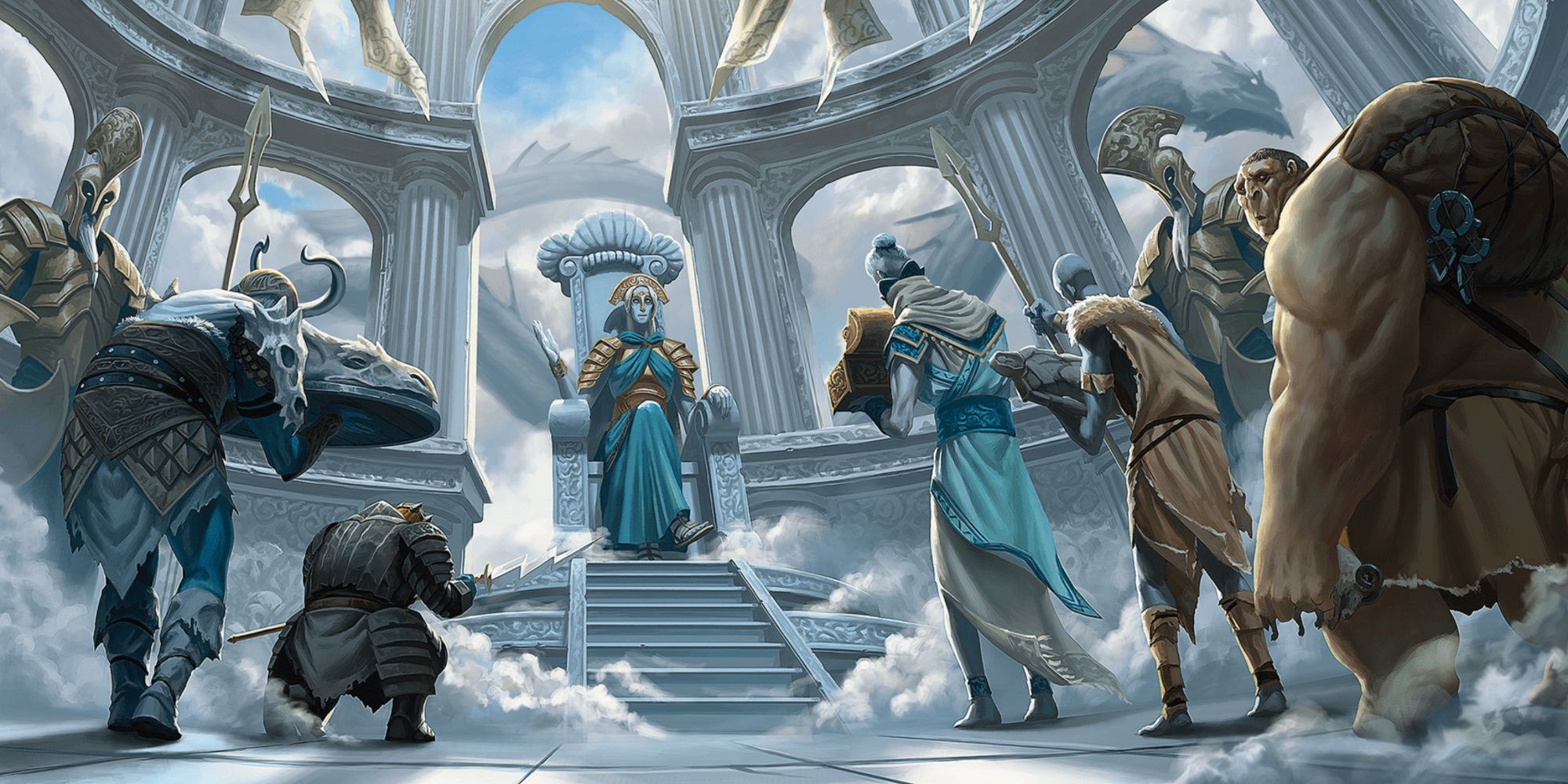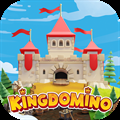Bigby Presents: Glory Of The Giants – The Gods Of The Ordning, Explained

Quick Links
- What Is The Ordning
- What Are The Origins Of The Ordning
- Who Is Annam?
- Who Are The Gods Of The Ordning?
Giants in Dungeons & Dragons are known to have several different types. Among them, the six most popular types of giants are represented the most in D&D. Each type of giant chooses to rank itself based on an individual factor chosen by the group. But how do you get these rankings, and what do they mean?
Related: Bigby Presents: Glory Of The Giants – Giant Foundling, Explained
With Bigby Presents: Glory of the Giants, we finally have the answer to how these giants are ranking themselves in their own social hierarchy known as The Ordning. There's also a hierarchy between the six major giant types themselves. So where did the ordning come from, and what affects these positions in the world of giants? Let's find out.
What Is The Ordning
Giant's Atlas by Jabari WeathersIn the simplest explanation, the ordning is a pantheon of gods comprised of Annam and his children. Giants have used this pantheon as the archetype, and the ordning is a social ranking system for giants. The giants use it to organize themselves with a very strict ranking. The six giant groups in the ordning ranked in order are:
- Storm Giants
- Cloud Giants
- Fire Giants
- Frost Giants
- Stone Giants
- Hill Giants
No specific giant can transcend this hierarchy. Storm giants will always remain at the top, meaning even the lowest storm giant will always rank higher than the best cloud giant. This also means the hill giants will always be at the bottom of this social hierarchy. These hierarchical positions cannot be transcended despite skill, strength, wealth, or any other factors.
Though other types of creatures are technically classified as giants, they are also not included in the ordning. You won't see any ettins, trolls, or any other creatures classified as giants.
Within this hierarchy is another, in which giants determine the social hierarchy within their own ranks. Each different type of giant uses a different measurement. Here's how they determine rank within their groups.
Giant Type
Ranking System
Storm Giant
Do not rank themselves
Stone Giant
Artistry and rock-throwing
Fire Giant
Crafting skills
Hill Giant
Respect larger and stronger giants, they don't care much about their own position.
Frost Giant
Physical strength
Cloud Giant
Wealth
As mentioned, even the most talented and artistic stone giant will never be able to transcend above the weakest frost giant. A giant's social standing in the ordning may help determinehow they react to others.
What Are The Origins Of The Ordning
Star Forge by Jessica FongMyths and legends surround the origins of the ordning, the most popular of those being ones that relate the giants and their ordning position to something as natural as the land surrounding them.
It's a scale that moves from the bottom (the hill giants representing the low hills), the stones on the mountain (stone giants), the cold frozen peaks (frost giants), the top of the volcano (fire giants), the peak of the mountain just through the clouds (cloud giants) and to the storms up above (storm giants), creating the perfect explanation for the natural order.
Conversely, there are stories that tell that the ordning is, in fact, not natural; in other stories, it's the downfall of the giants. Annam is said to have either established the ordning based on the hierarchy mentioned prior, or it came about as a consequence or punishment. This punishment revolves around the giants falling from Annam's grace, with his sons making the ordning as a distraction of sorts, a consequence for their fall, and a distortion of Annam's will.
How Do Giants Reject The Ordning
There are only three reasons a giant will reject the ordning, whether partially or entirely. This can come in many variations of the following forms:
Giants That Reject The Ordning
How They Reject The Ordning
Hold Different Standards
Giants who hold different values and standards will easily be seen as outcasts in their groups. If a fire giant is interested in strength, or a frost giant is extremely knowledgable, they'd be at the bottom of their internal hierarchy and will want to find a way out.
In this instance, being skilled in anything other than what you're supposed to be can be detrimental. Holding different standards will cause you to reject the ordning, mostly for your own benefit and maybe for your survival.
Revolutionary Individuals
These giants come to terms with being the best at their craft and will sometimes want to surpass their own ordning level and exert their talents over others, including those in a different ordning category. As mentioned, giants cannot remove themselves from this hierarchy, so their efforts will be in vain.
This can cause struggle and turmoil within that group's social hierarchy, but a giant who cannot progress may end up rejecting the ordning altogether, instead choosing a life in which they can exert their dominance over lesser giants not in the ordning or other creatures altogether.
Religious Beliefs
Placing their belief in any other gods aside from Annam and his children means rejecting the ordning and the hierarchy put in place by the gods. In many situations, a giant may choose to ally with a religious group that puts them above their position in the ordning, whether that group be evil or good.
This is all to say that even within the ordning, giants are individuals who won't always align with the established hierarchy, whether for good or ill. If you're using giants in your game, be sure to invest in their backgrounds by involving their history and the ordning and how it affects their decisions.
Who Is Annam?
Path of the Pilgrim by Brian ValezaAnnam's history is unknown, though he is most regarded as the All father, whose children are the gods that comprise the ordning. In some stories, he is said to be the creator of worlds, with gods populating the worlds he created. Giants respect this Annam and his divine children and his ordning and hierarchy.
Most giants, however, respect Annam's children more than him, as he's seen as a distant figure, whereas his children are much more connected to the giants. They do not like that Annam has abandoned them.
Some stories report Annam as an all-knowing god who worked together to create other worlds. However, all agree that now he is no longer active in the affairs of his children, the giants on the Material Plane. Even still, some giants and regions do not recognize the ordning at all. You may find yourself in a region where giants do not respect the ordning or even have a separate social hierarchy not at all governed by the ordning.
Who Are The Gods Of The Ordning?
Giant Fight by Dmitry BurmakAside from Annam, there are ten other gods of the ordning. These gods are revered by the giants, with each representing a different quality one of the giant factions respects.
God of the Ordning
Alignment
Revered Quality
Diancastra
Chaotic Neutral
Diancastra is the youngest of Amman's children. She is revered for her clever deeds, most notably her cleverness, bravery, and trickery with the aid of magic. Giants who want something done or use their brains and cleverness over their brawn may worship her.
Grolnator
Chaotic Evil
Strength and pride exemplify Grolnator. The youngest son of Amman, his strength is one of his only redeeming qualities, as most of his siblings see him as just a brute. He believes in strength above all and likes to disregard the ordning as it doesn't place him where he thinks he truly belongs based on his ability.
Hill giants and frost giants who admire his strength will worship him, as will lesser giant creatures who think brute force is the way to go.
Hiatea
Neutral
The bountiful mother of the land, Hiatea is the god who most giants can pray to for hearth and home. As Annam's second child, she is known as a source of bounty, agricultural blessings and a master of nature.
A protective mother figure who cares about community, many giants find themselves praying for harvest, bounty, and agriculture from Hiatea. Still, others pray for community and education regarding her other, more community-oriented side.
Iallanis
Neutral Good
Almost the opposite of Grolantor, Iallanis is sweet, kind, caring, joyful, and any other peaceful and positive adjective you can think of. She believes in restoring the giant's empire, but as peaceful leaders and innovators, not tyrants.
Love, healing, and harmony lead her charge. Artistic giants, such as the stone giants, worship her for her love of nature. Most wedding commencements are officiated by her priests as well, even between evil giants. Any giant who has good aligned qualities will find her intriguing.
Karontor
Neutral Evil
Grolnator's older twin, Karontor is just as chaotic, if not more so. An evil schemer, it's said that Karontor was banished to a subterranean prison after inciting an assault against the Feywild.
Karontor is not worshipped in the open, as it's believed that worshipping him may summon him from his prison and bring ill will to those above, or they'll be pulled below to worship him where he sits. Even his name isn't uttered aloud, with nicknames that refer to him taking its place. There will inevitably be evil cults that worship him, mostly in secret.
Memnor
Neutral or Neutral Evil
Probably the most manipulative of the gods, Memnor is seen as either Neutral or Neutral Evil based on who you believe regarding his nature. Duplicity, manipulation, and trickery are his standards, whereas self-interest is his goal. He does use cunning trickery and intelligence to enact these tricks, something giants may worship him for.
Memnor is said to not only get himself in trouble with Amman but also his siblings. Stories accuse him of wanting to usurp the ordning from Amman, with some even stating he's the evil twin of Amman. He's so good at his trickery that you may never know the truth.
Skoraeus
Neutral
The wisest of the gods, Skoraeus is the fifth son of Amman. He's sought out for his knowledge, particularly his understanding of the earth and its secrets. His expertise includes magic, wards, hidden items and treasure, and a true understanding of the earth and how to work with it.
Giants who regarded stonework and artistry will worship him, as will those interested in his knowledge of magic. Fire and stone giants may find particular use in praying to him. Stone giants even have a nickname for him "Stonebones."
Stronmaus
Neutral Good
The oldest of Annam's children, Stronmaus was originally perpetually happy. He could only see the good in things, including his siblings (even the evil ones), just a total optimist. Once Amman backed away from the ordning however, Stronmaus was left in charge. He lost his sunny disposition, having it replaced by frustration at his inability to restore the ordning.
Seen as just a substitute for Amman who isn't doing the job particularly well, giants will worship him as a requirement as the head of the ordning. Mostly, the strongest of their hierarchy will send the required prayers to him while hoping and waiting for Amman.
Surtur
Lawful Evil
The older twin of Thrym, Surtur is known for his amazing metalworking skills. Weapons, armor, and the forge are all parts of his expertise, and worshippers looking to create those items or work with a smith will send prayers his way.
Fire giants can pray for inspiration or blessings when creating weapons and armor for a large-scale battle.
Thrym
Chaotic Evil
Often shown as the greatest warrior of the ordning, Thyrm is the twin of Sutur. Most worshippers will pour a blood sacrifice from their kills to him. Before going to war or to hunt, Thyrm will receive prayers and requests for blessings.
Next: Bigby Presents: Glory Of The Giants – Path Of The Giant Barbarian Build













